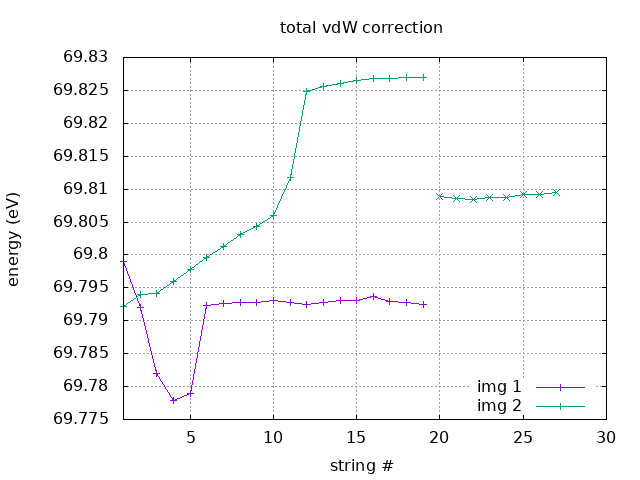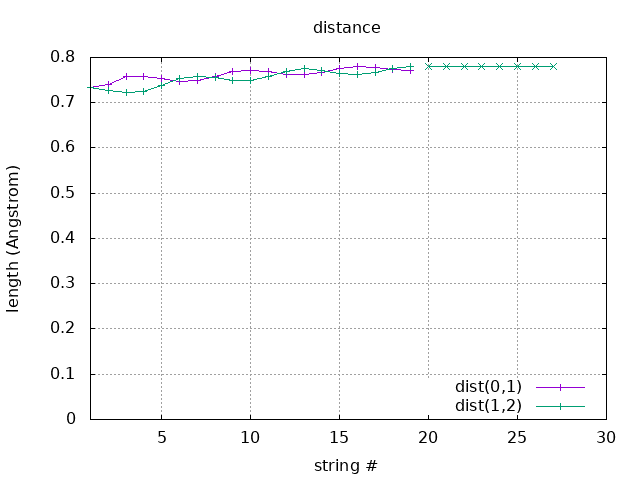vdw correction convergence problem
Posted: Sat Mar 24, 2018 11:39 am
Hello everyone,
I'm looking for an energy barrier of H diffusion from a V surface including van der Waals corrections (vdW-DF2). I use a climbing string method (cf. http://www.math.nus.edu.sg/~matrw/papers/jcp2013.pdf) patched into VASP/VTST by myself a while ago. One end of the climbing string is pinned in the energy minimum, all other images align on the MEP, the last of which converges to the saddle point during a successful run.
Such a run with just 2 moving images starting from a particularly good initial guess is visualized by the following plots:

You can see the simultaneous evolution of the images' energies relative to the stable minimum (+ symbols) and the subsequent saddle point refinement by conjugate gradient (x symbols). The convergence problem is the energy drop of img 2 (string# 10 to 12) and img 1 (string# 4 to 6) . When doing the saddle point refinement starting form the last iteration of image 2, the energy converges to the level prior to the sudden energy drop.

I think this is due to some problem with the vdw correction because plotting the total vdW correction (parsed form std out lines containing "Total vdW correction in eV:" at every electronic minimization loop) reveals obvious features at the very same iterations where the energy drops are observed above, i.e. string# 12 to 12 for image 2 and string# 4 to 6 for image 1.

Note there are no such features in the maximum ion forces at those iterations.

The images' distances to another also do not stand out at those iterations. The slight oscillations are expected as the distances are regulated by NEB-like nudging forces.
The full INCAR of the full climbing string run is
Any suggestion is greatly appreciated. Thank you very much in advance!
I'm looking for an energy barrier of H diffusion from a V surface including van der Waals corrections (vdW-DF2). I use a climbing string method (cf. http://www.math.nus.edu.sg/~matrw/papers/jcp2013.pdf) patched into VASP/VTST by myself a while ago. One end of the climbing string is pinned in the energy minimum, all other images align on the MEP, the last of which converges to the saddle point during a successful run.
Such a run with just 2 moving images starting from a particularly good initial guess is visualized by the following plots:

You can see the simultaneous evolution of the images' energies relative to the stable minimum (+ symbols) and the subsequent saddle point refinement by conjugate gradient (x symbols). The convergence problem is the energy drop of img 2 (string# 10 to 12) and img 1 (string# 4 to 6) . When doing the saddle point refinement starting form the last iteration of image 2, the energy converges to the level prior to the sudden energy drop.

I think this is due to some problem with the vdw correction because plotting the total vdW correction (parsed form std out lines containing "Total vdW correction in eV:" at every electronic minimization loop) reveals obvious features at the very same iterations where the energy drops are observed above, i.e. string# 12 to 12 for image 2 and string# 4 to 6 for image 1.

Note there are no such features in the maximum ion forces at those iterations.

The images' distances to another also do not stand out at those iterations. The slight oscillations are expected as the distances are regulated by NEB-like nudging forces.
The full INCAR of the full climbing string run is
The full run for the subsequent saddle point refinement by conjugate gradient:AGGAC = 0.0
ALGO = Fast
EDIFF = 0.0001
EDIFFG = -0.03
ENCUT = 520
GGA = Ml
ICHARG = 1
ISIF = 0
ISMEAR = 1
ISPIN = 2
KPAR = 4
LASPH = True
LORBIT = 11
LREAL = Auto
LUSE_VDW = True
LWAVE = False
MAGMOM = 64*0.0 1*1.0 1*-1.0
NCORE = 64
NELM = 60
NELMDL = -7
NELMIN = 4
NSW = 1000
NUPDOWN = 0.0
PREC = Accurate
SIGMA = 0.1
Zab_vdW = -1.8867
# VTST/CSM settings:
IBRION = 3
POTIM = 0.0
ICHAIN = 99
IMAGES = 2
CSMEMIN = -378.79317
CSMSPRING = 5.0
IOPT = 4
MAXMOVE = 0.1
SDALPHA = 0.1
I can't make sense of this problem. While I'm not very experienced using vdW corrections, from what I read using the above INCAR files with the standard PBE potentials for V (5 electrons) and H should be no fundamental mistake, or is it?AGGAC = 0.0
ALGO = Very Fast
EDIFF = 0.00001
EDIFFG = -0.01
ENCUT = 520
GGA = Ml
ICHARG = 1
ISIF = 0
ISMEAR = 1
ISPIN = 2
KPAR = 4
LASPH = True
LORBIT = 11
LREAL = Auto
LUSE_VDW = True
LWAVE = False
MAGMOM = 64*0.0 1*1.0 1*-1.0
NCORE = 64
NELM = 80
#NELMDL = -7
NELMIN = 4
NSW = 1000
NUPDOWN = 0.0
PREC = Accurate
SIGMA = 0.1
Zab_vdW = -1.8867
# VTST/CSM settings:
IBRION = 3
POTIM = 0.0
ICHAIN = 99
CSMSDLIMG = 2
CSMEMIN = -378.79317
CSMSPRING = 5.0
IOPT = 2
#MAXMOVE = 0.1
#SDALPHA = 0.1
Any suggestion is greatly appreciated. Thank you very much in advance!